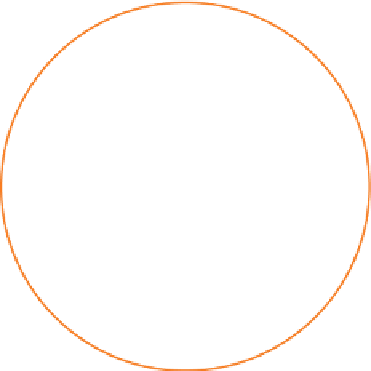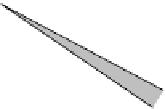Geology Reference
In-Depth Information
Box 11.1 Types of meteorite, shown in proportion to percentage of total falls
1
Chondrites and
achondrites are
grouped together
as 'stones'
CHONDRITES
85%
Texture:
All (except Cl type)
are characterised by spherical
chrondules
2
in an agglomerate
matrix (Plate 5):
ACHONDRITES (Plate 6) 10%
comprising pyroxene
±
plagioclase
±
olivine
often with igneous texture.
Negligible metal present.
Mineralogy
(1)
Silicates (olivine,
pyroxenes, plagioclase
±
hydrous silicates like
serpentine)
IRONS (Fig. 11.1.1) 3.5%
comprising >90% metallic
phases.
Octahedrites
6
consist
of kamacite
3
exsolution
lamellae in a taenite
4
host.
(2) Metal
3
and/or
troilite (FeS)
(3)
±
carbonaceous
material
5
STONY IRONS 1.5%
roughly 50:50 admixture
of differentiated metal
and silicate phases
m
1 'Falls' are meteorite samples that have been seen to fall,
as opposed to those just discovered on the ground
('finds'). Relative numbers of 'falls' give the best estimate
of the relative abundance of the different meteorite types.
2 Chondrules (see plate 5) are millimetre-sized spheroidal
clusters of crystals and glassy material, thought to have
originated as molten droplets in the presence of a gas
(Lauretta
et al
., 2006). Crystals often show evidence of
having been rapidly chilled.
3 Kamacite ~ Fe
95
Ni
5
.
4 Taenite, typically with a composition of Fe
60
Ni
40
(see
Figure 3.5.1 in Box 3.5).
5 The carbonaceous component characteristic of the
carbonaceous chondrite
group is a complex tarry mixture
of abiogenic organic compounds.
6 So called because, owing to the cubic symmetry of the
taenite host, the kamacite plates have four orientations
parallel to the faces of a regular octahedron. This dis-
tinctive texture, most apparent in a flat surface that has
been etched with acid (Figure 11.1.1), is called
Widmanstätten structure after the austrian count who
discovered it in 1808.
Figure 11.1.1
The acid-etched surface of an octahedrite
6
iron meteorite (Canyon Diablo iron), exposing the internal
Widmanstätten texture of kamacite
3
lamellae in a taenite
4
host. The specimen is 15 cm in length. (Source: © The
Natural History Museum, London. Reproduced with
permission.)








Search WWH ::

Custom Search